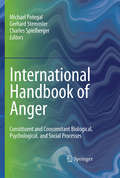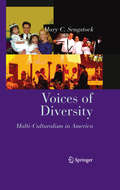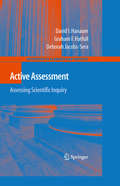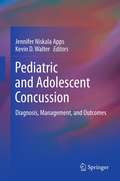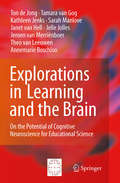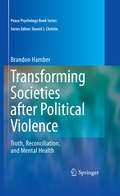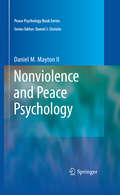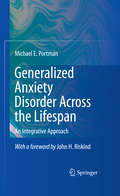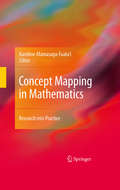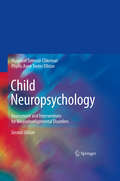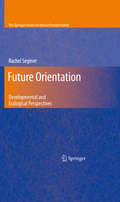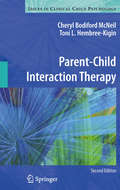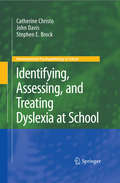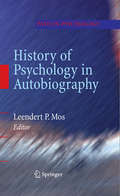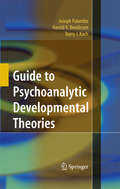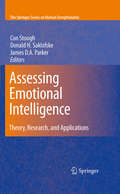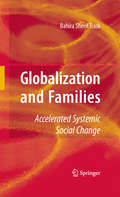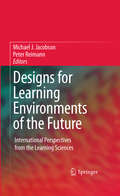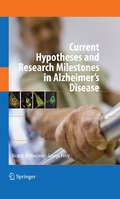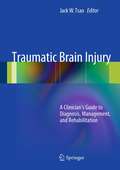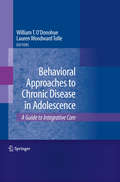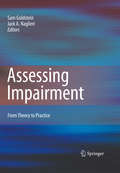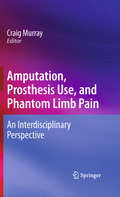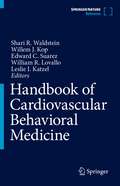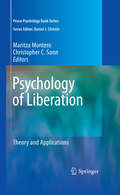- Table View
- List View
International Handbook of Anger
by Gerhard Stemmler Charles Spielberger Michael PotegalBook covers a broader range of topics than other books in this area. Notably, extensive coverage of the neurobiology of anger in context of psychology and sociology is unique. Book provides broad, integrative coverage while avoiding unnecessary duplication. Contributors have read each others' chapters and there is extensive cross-referencing from chapter to chapter. Book contains a guide to content and organization of chapters and topics, along with interpolated commentary at the end of each section.
Voices of Diversity
by Brenda Marshall Arifa Javed Mary C. Sengstock Sonya BerkeleyThe 21st century sees an increasing number of cultural minorities in the United States. Particularly, the rise in multi-cultural or mixed heritage families is on the rise. As with many trends, just as the amount of diversity increases, so does the level of resistance in groups that oppose this diversity. While this problem exists through life for persons from multicultural backgrounds, the tension is particularly acute for children, whose identities and socialization experiences are still in formation. With parents from different cultural backgrounds, as well as school and community experiences giving that might question their diverse heritage, children are likely to experience distressing confusion. How can they come to terms with this conflict, and how can family and community help them to resolve it? Combining case studies and interviews, this work particularly focuses on multi-cultural families as a yet untapped source of information about inter-culture contact. Voices of Diversity: Multiculturalism in America will be both a resource for researchers and practitioners, as well as a practical guide to families dealing with these issues every day.
Active Assessment: Assessing Scientific Inquiry (Mentoring in Academia and Industry #2)
by David I. Hanauer Debbie Jacobs-Sera Graham F. HatfullThe book is designed to provide a theoretical introduction to the field of active assessment, a practical guide to the development of assessment tools for scientific inquiry and a case study of a specific development and implementation process of assessment in a scientific inquiry program. As currently designed the book would have two sections: the first, theoretical and practical developing the concepts of how assessment is developed and implemented and the second section, a case study from research work conducted in the outreach program of the Bacteriophage Institute of Pittsburgh. The book is designed for a wide market of scientists involved in scientific education laboratory work. As with the original research project, this book breaks new ground in the area of scientific education and assessment and at this current time there is no book or research monograph that explicates a serious, comprehensive approach to the assessment of scientific inquiry. It is important to note that according to all the central bodies involved in science education (see the National Research Council's standards for science education) that the use of scientific inquiry is the preferred method of teaching science. Accordingly a book of this type should provide an important service for all active scientific inquiry programs in that it presents for the first time a concept and method for assessing scientific inquiry on the undergraduate and graduate levels. This book could provide an interesting answer to this situation of a required educational context without developed methodologies for evaluation.
Pediatric and Adolescent Concussion
by Jennifer Niskala Apps Kevin D. WalterBetween the growing numbers of children and adolescents playing sports and the increased attention to head injuries by the larger sports community and the general public, pediatric concussions are emerging as a major concern. And as practitioners are seeing more young clients with head injuries, questions arise about age-appropriate assessment, diagnosis, treatment, and return to activity. Pediatric and Adolescent Concussion: Diagnosis, Management, and Outcomes offers evidence-based guidelines where few previously existed. This comprehensive volume clearly explains the effects of traumatic injury on the developing brain in sports- and non-sports-related contexts, and establishes a framework for immediate and long-term management, especially the crucial first 24 hours. Chapters provide a basic grounding in its subject with a history of concussion as a medical entity and a review of definitional and classification issues, take the reader through the steps of a neuropsychological evaluation, pinpoint post-injury issues, and offer strategies for the prevention of further or future injury. Pediatric and Adolescent Concussion: Diagnosis, Management, and Outcomes serves as both educational resource and practical framework for a wide array of professionals, including neuropsychologists, sports medicine physicians, child psychologists and psychiatrists, pediatric and family physicians, athletic trainers, social workers, and educators.
Explorations in Learning and the Brain
by Theo Van Leeuwen Tamara Van Gog Ton De Jong Janet Van Hell Kathleen Jenks Annemarie Boschloo Jeroen Van Merrienboer Sarah Manlove Jelle JollesThe past decade has witnessed efforts on the part of research, education and policy communities to create a dialogue about the potential relationship between cognitive neuroscience and the science and practice of education. The upsurge of interest in neuroscience in general has given rise to increased attention to the role of the brain in learning. However, much of the debate has been dominated by extremes. Explorations in Learning and the Brain takes a different stance in the sense that developments within neuroscience are not the starting point but rather uses major questions dominant in educational research, notably instructional systems design and related fields within the educational sciences, as its basis. The book identifies interfaces between neuro-scientific and educational research, and informs on potentially interesting additions to educational research and viable interdisciplinary ventures.
Transforming Societies after Political Violence
by Brandon HamberTransforming Societies after Political Violence explores the relationship between the individual and the political and social contexts in which victims or survivors of violence find themselves. The book delves into the complex interplay between individual psychological processes and macro-political interventions such as truth commissions. During times of political transition, it is vital that there exists a bridge between what takes place at the national or political level and the personal experience of the victim or survivor of political violence. This is where the work in and around transitional justice processes--undertaken by policymakers, survivors themselves, and those working to assist or support them--can be of great benefit. Supporting victims, once they are ready, to be active agents within their environment is critical. In short, the book demonstrates how dealing with the legacy of individual experience of violence and collective processes of peacebuilding can be better integrated to make a lasting peace in societies in transition.
Nonviolence and Peace Psychology
by Daniel MaytonRecent trends and events worldwide have increased public interest in nonviolence, pacifism, and peace psychology as well as professional interest across the social sciences. Nonviolence and Peace Psychology assembles multiple perspectives to create a more comprehensive and nuanced understanding of the concepts and phenomena of nonviolence than is usually seen on the subject. Through this diverse literature--spanning psychology, political science, religious studies, anthropology, and sociology--peace psychologist Dan Mayton gives readers the opportunity to view nonviolence as a body of principles, a system of pragmatics, and a strategy for social change. This important volume: Draws critical distinctions between nonviolence, pacifism, and related concepts. Classifies nonviolence in terms of its scope (intrapersonal, interpersonal, societal, global) and pacifism according to political and situational dimensions. Applies standard psychological concepts such as beliefs, motives, dispositions, and values to define nonviolent actions and behaviors. Brings sociohistorical and cross-cultural context to peace psychology. Analyzes a century's worth of nonviolent social action, from the pathbreaking work of Gandhi and King to the Courage to Refuse movement within the Israeli armed forces. Reviews methodological and measurement issues in nonviolence research, and suggests areas for future study. Although more attention is traditionally devoted to violence and aggression within the social sciences, Nonviolence and Peace Psychology reveals a robust knowledge base and a framework for peacebuilding work, granting peace psychologists, activists, and mediators new possibilities for the transformative power of nonviolence.
Generalized Anxiety Disorder Across the Lifespan
by Michael E. PortmanGeneralized anxiety disorder is a chronic, disabling, often lifelong condition affecting millions worldwide. Yet, despite its prevalence, GAD is frequently marginalized, misdiagnosed, and undertreated. Generalized Anxiety Disorder Across the Lifespan creates a practical knowledge base for GAD, identifying the symptoms that set it apart both from "normal, everyday" anxiety and from other anxiety-based pathologies, and thoroughly reviewing the range of established and cutting-edge treatments. The author's developmental approach sheds some light on longstanding clinical mysteries surrounding the disorder, among them the interplay of somatic and psychological symptoms and the changes in symptoms as patients age. Accessible to the novice or the veteran reader, the book: Grounds readers in the basics of GAD Offers extensive discussion of the current psychosocial treatments for GAD Examines the state of the art in pharmacological therapies with explanations of the genetic and neurobiological correlates Explores special issues, cultural considerations, treatment resistant patients, and prevention Includes guidelines for treatment of GAD in children, adolescents, adults, and older adults Features ready-to-use assessment tools for clients across the lifespan. Generalized Anxiety Disorder Across the Lifespan is a rich resource for clinicians, researchers, and graduate students looking to improve patients' quality of life--and the quality of their care. It is both a guide to current best practice and a springboard for future innovations.
Concept Mapping in Mathematics: Research into Practice
by Karoline Afamasaga-Fuata'IConcept Mapping in Mathematics: Research into Practice is the first comprehensive book on concept mapping in mathematics. It provides the reader with an understanding of how the meta-cognitive tool, namely, hierarchical concept maps, and the process of concept mapping can be used innovatively and strategically to improve planning, teaching, learning, and assessment at different educational levels. This collection of research articles examines the usefulness of concept maps in the educational setting, with applications and examples ranging from primary grade classrooms through secondary mathematics to pre-service teacher education, undergraduate mathematics and post-graduate mathematics education. A second meta-cognitive tool, called vee diagrams, is also critically examined by two authors, particularly its value in improving mathematical problem solving. Thematically, the book flows from a historical development overview of concept mapping in the sciences to applications of concept mapping in mathematics by teachers and pre-service teachers as a means of analyzing mathematics topics, planning for instruction and designing assessment tasks including applications by school and university students as learning and review tools. This book provides case studies and resources that have been field tested with school and university students alike. The findings presented have implications for enriching mathematics learning and making problem solving more accessible and meaningful for students. The theoretical underpinnings of concept mapping and of the studies in the book include Ausubel's cognitive theory of meaningful learning, constructivist and Vygotskian psychology to name a few. There is evidence particularly from international studies such as PISA and TIMSS and mathematics education research, which suggest that students' mathematical literacy and problem solving skills can be enhanced through students collaborating and interacting as they work, discuss and communicate mathematically. This book proposes the meta-cognitive strategy of concept mapping as one viable means of promoting, communicating and explicating students' mathematical thinking and reasoning publicly in a social setting (e.g., mathematics classrooms) as they engage in mathematical dialogues and discussions. Concept Mapping in Mathematics: Research into Practice is of interest to researchers, graduate students, teacher educators and professionals in mathematics education.
Child Neuropsychology: Assessment And Interventions For Neurodevelopmental Disorders,
by Margaret Semrud-Clikeman Phyllis Anne Teeter EllisonDuring the past decade, significant advances have been made in the field of neurodevelopmental disorders, resulting in a considerable impact on conceptualization, diagnostics, and practice. The second edition of Child Neuropsychology: Assessment and Interventions for Neurodevelopmental Disorders brings readers up to speed clearly and authoritatively, offering the latest information on neuroimaging technologies, individual disorders, and effective treatment of children and adolescents. Starting with the basics of clinical child neuropsychology and functional anatomy, the authors present a transactional framework for assessment, diagnosis, and intervention. The book carefully links structure and function--and behavioral and biological science--for a more nuanced understanding of brain development and of pathologies as varied as pervasive developmental disorders, learning disabilities, neuromotor dysfunction, seizure disorders, and childhood cancers. This volume features a range of salient features valuable to students as well as novice and seasoned practitioners alike, including: Overview chapters that discuss the effects of biogenic and environmental factors on neurological functioning. New emphasis on multicultural/cross-cultural aspects of neuropsychology and assessment. Brand new chapters on interpretation, neuropsychological assessment process, and report writing. An integrative model of neurological, neuroradiological, and psychological assessment and diagnosis. Balanced coverage of behavioral, pharmacological, and educational approaches to treatment. Case studies illustrating typical and distinctive presentations and successful diagnosis, treatment planning, and intervention. Important practice updates, including the new HIPAA regulations. Child Neuropsychology, 2nd Edition, is vital reading for school, clinical child, and counseling psychologists as well as neuropsychologists. The book also provides rich background and practical material for graduate students entering these fields.
Future Orientation
by Rachel SeginerWhere am I going? What do I want to do with my life? Such questions are typical of--even essential to--adolescence and continue to influence individuals throughout their lifetimes. And although human beings are capable of anticipating future events even as infants, the teen years are the peak period for weighing options and setting long-range goals. Future Orientation: Development and Ecological Perspectives synthesizes a wealth of theory and empirical data to explore future thinking as both a developmental process and an individual one. Starting with its origins in childhood, the book identifies the forces that affect this evolution, from early interactions with parents to personality traits and self-processes. Adolescents' future orientation is analyzed by its influences--a complex network of gender expectations, family and peer relationships, and cultural variables--and is, in turn, linked to developmental outcomes at school, capacity for intimacy, and adjustment in emerging adulthood and in adult life. This unique volume: Examines future orientation as an aspect of positive psychology, focusing on the stages of preadolescence, adolescence, and emerging adulthood. Relates future orientation with other psychological constructs relevant to this age group, including identity and self-esteem. Offers ecological and developmental perspectives to explore the effects of family members and peer groups on future thinking. Compares adolescent future thinking across cultures and discusses the roles of gender and gender constructs in future orientation. Complements developmental and educational psychology as well as counseling and parental guidance courses. Given the current climate of rapid social change, Future Orientation is an invaluable reading for researchers, clinicians, and practitioners, including child and school psychologists, psychiatrists, counselors, social workers, and others who work with young people during this critical juncture.
Parent-Child Interaction Therapy
by Cheryl Bodiford Mcneil Toni L. Hembree-KiginOver the past two decades, Parent-Child Interaction Therapy (PCIT) emerged as a leading-edge method for helping parents improve their children's disruptive and oppositional behavior. Today, PCIT has a robust evidence base; is used across the country in settings as diverse as hospitals, mental health centers, schools, and mobile clinics; and is rapidly gaining popularity in other parts of the world. In keeping with this increasing recognition of PCIT's effectiveness, the authors of Parent-Child Interaction Therapy present this expanded clinical edition to keep readers up to date on new practice developments, current treatment protocols, and the latest research findings. This update retains the fundamentals as detailed by PCIT's founder, Dr. Sheila Eyberg, including an overview of the therapy, detailed description of the course of treatment, and handout materials. The text goes further to explore the evolution of PCIT outside the original target ages of three-to-six (including preventive PCIT for very young children at risk) and examines the use of PCIT with special child populations, such as abuse victims and those with ADHD. Contributing experts discuss uses of the therapy in school, at home, with minorities, and with highly stressed families. But regardless of the population, setting, or topic covered, interventions remain faithful to basic PCIT principles and methods. New features of the expanded second edition include: Adaptations of PCIT for babies, toddlers, preteens, and siblings.Applications for abuse survivors, children with developmental disabilities, ADHD, and severe aggression problems. Uses of PCIT with separating or divorced parents.Culturally relevant PCIT for ethnic minority and international families.Teacher-child, staff-child, and home-based applications.PCIT training guidelines.A brand-new chapter summarizing current research supporting PCIT.As PCIT broadens its scope, Parent-Child Interaction Therapy, Second Edition, brings innovative ideas and proven techniques to clinical child psychologists, school psychologists, and other mental health providers working to enhance the lives of children and their families.
Identifying, Assessing, and Treating Dyslexia at School
by John M. Davis Catherine Christo Stephen E. BrockAs many as one in four children experiences problems with reading. Dyslexia, the most common learning disability leads to well-documented negative effects on school and, ultimately, adult success. Therefore, it is critical that school professionals provide early and effective assessment and intervention. Identifying, Assessing, and Treating Dyslexia at School equips practitioners with in-depth understanding of the disorder and a wealth of practical information for meeting student needs. This volume: Reviews up-to-date findings on dyslexia - causes, prevalence, and related conditions. Provides research-based tools for identifying and addressing dyslexia. Offers a detailed framework for case finding and screening, diagnostic and psychoeducational assessment as well as age- and grade-appropriate intervention. Explains the roles and responsibilities of school psychologists when it comes to identifying students with dyslexia. Focuses solely on dyslexia, unlike most other books on learning disabilities. As the duties of school psychologists and related education professionals become more complex, recognizing and providing services for students with learning disorders has become progressively more demanding. Identifying, Assessing, and Treating Dyslexia at School offers practitioners an accessible and easy-to-read reference that they will use for years to come.
History of Psychology in Autobiography
by Leendert P. MosSince the 17th century, autobiography has an honorable place in the study of history. In 1930, the preeminent historian of psychology, Edwin Boring, writes that a science separated from its history lacks direction and promises a future of uncertain importance. To understand what psychology is and what it is becoming, the autobiographies of famous psychologists is history at it best. Here we find model inquirers of the science who offer a personalized account of themselves and their vocation in the context of the history of the science. What is characteristic of many of those who have contributed to an alternate vision of psychological science is that they never considered themselves, or were considered by others, as belonging to the mainstream of the discipline. In considering an alternative history of psychology in autobiography, the editor invited contributors whose research and writings have pushed the discipline in other directions, pushed its limits, and whose scholarship finds its philosophical framework outside the discipline altogether. If these contributors may not be model inquirers, their scholarship is very much a matter of consequence for those who wish to understand psychology. Among the outliers included here are those who devoted themselves to the writing of psychology, examining its history, theories, research and professional practices, and who enthusiastically embraced, over the course of their lives, the discipline as a human science. Their influence has been subtle as has been their appeal to many students who affection for the discipline finds its promise in a discerning self-awareness and a critical understanding of others and their worlds. This volume is not simply a collection of personal chronologies which might inspire or lend appreciation to a younger generation. Our contributors write from their personal and professional experience, of course, but they write of their thinking and understanding of the psyche as an aspect of human life, of psychology as an academic form of human sciences' inquiry, and so bring to bear their scientific and philosophical imagination to their personal challenges in their chosen vocation as psychologists. Our contributors cover a broad swath of the second half of the 20th century, the century of psychology. Nurturing the discipline from within various philosophical, social-political, and cultural roots, their autobiographies exemplify marginality, if not alienation, from the mainstream, even as their professional and personal lives give expression to engaged scholarship, commitment to vocation and, straightforwardly and reflectively, a love of the heart. From Germany, Carl Graumann, from France, Erika Apfelbaum, from Canada, David Bakan and Kurt Danziger, and from the United States, Amedeo Giorgi, Robert Rieber, and Joseph Rychlak, relate their lives to the larger contexts of our times. Their personal stories are an integral part of the historiography of our discipline. Indeed, a contribution to historiography of our discipline is constituted in their autobiographical self-presentations, for their writings attest as much to their lives as model inquirers as they do to the possibility of psychology as a human science.
Guide to Psychoanalytic Developmental Theories
by Joseph Palombo Harold K. Bendicsen Barry J. KochAs the foundational theory of modern psychological practice, psychoanalysis and its attendant assumptions predominated well through most of the twentieth century. The influence of psychoanalytic theories of development was profound and still resonates in the thinking and practice of today's mental health professionals. Guide to Psychoanalytic Developmental Theories provides a succinct and reliable overview of what these theories are and where they came from. Ably combining theory, history, and biography it summarizes the theories of Freud and his successors against the broader evolution of analytic developmental theory itself, giving readers a deeper understanding of this history, and of their own theoretical stance and choices of interventions. Along the way, the authors discuss criteria for evaluating developmental theories, trace persistent methodological concerns, and shed intriguing light on what was considered normative child and adolescent behavior in earlier eras. Each major paradigm is represented by its most prominent figures such as Freud's drive theory, Erikson's life cycle theory, Bowlby's attachment theory, and Fonagy's neuropsychological attachment theory. For each, the Guide provides: biographical information a conceptual framework contributions to theory a clinical illustration or salient excerpt from their work. The Guide to Psychoanalytic Developmental Theories offers a foundational perspective for the graduate student in clinical or school psychology, counseling, or social work. Seasoned psychiatrists, analysts, and other clinical practitioners also may find it valuable to revisit these formative moments in the history of the field.
Assessing Emotional Intelligence: Theory, Research, and Applications (The Springer Series on Human Exceptionality)
by James D. Parker Donald H. Saklofske Con StoughManaging human emotions plays a critical role in everyday functioning. After years of lively debate on the significance and validity of its construct, emotional intelligence (EI) has generated a robust body of theories, research studies, and measures. Assessing Emotional Intelligence: Theory, Research, and Applications strengthens this theoretical and evidence base by addressing the most recent advances and emerging possibilities in EI assessment, research, and applications. This volume demonstrates the study and application of EI across disciplines, ranging from psychometrics and neurobiology to education and industry. Assessing Emotional Intelligence carefully critiques the key measurement issues in EI, and leading experts present EI as eminently practical and thoroughly contemporary as they offer the latest findings on: EI instruments, including the EQ-I, MSCEIT, TEIQue, Genos Emotional Intelligence Inventory, and the Assessing Emotions Scale. The role of EI across clinical disorders. Training professionals and staff to apply EI in the workplace. Relationships between EI and educational outcomes. Uses of EI in sports psychology. The cross-cultural relevance of EI. As the contributors to this volume in the Springer Series on Human Exceptionality make clear, these insights and methods hold rich potential for professionals in such fields as social and personality psychology, industrial and organizational psychology, psychiatry, business, and education.
Globalization and Families
by Bahira TraskAs our world becomes increasingly interconnected through economic integration, technology, communication, and political transformation, the sphere of the family is a fundamental arena where globalizing processes become realized. For most individuals, family in whatever configuration, still remains the primary arrangement that meets certain social, emotional, and economic needs. It is within families that decisions about work, care, movement, and identity are negotiated, contested, and resolved. Globalization has profound implications for how families assess the choices and challenges that accompany this process. Families are integrated into the global economy through formal and informal work, through production and consumption, and through their relationship with nation-states. Moreover, ever growing communication and information technologies allow families and individuals to have access to others in an unprecedented manner. These relationships are accompanied by new conceptualizations of appropriate lifestyles, identities, and ideologies even among those who may never be able to access them. Despite a general acknowledgement of the complexities and social significance inherent in globalization, most analyses remain top-down, focused on the global economy, corporate strategies, and political streams. This limited perspective on globalization has had profound implications for understanding social life. The impact of globalization on gender ideologies, work-family relationships, conceptualizations of children, youth, and the elderly have been virtually absent in mainstream approaches, creating false impressions that dichotomize globalization as a separate process from the social order. Moreover, most approaches to globalization and social phenomena emphasize the Western experience. These inaccurate assumptions have profound implications for families, and for the globalization process itself. In order to create and implement programs and policies that can harness globalization for the good of mankind, and that could reverse some of the deleterious effects that have affected the world's most vulnerable populations, we need to make the interplay between globalization and families a primary focus.
Designs for Learning Environments of the Future
by Peter Reimann Michael J. JacobsonFew things are as certain as societal changes--and the pressing need for educators to prepare students with the knowledge and ways of thinking necessary for the challenges in a changing world. In the forward-thinking pages of Designs for Learning Environments of the Future, international teams of researchers present emerging developments and findings in learning sciences and technologies at the infrastructure, curricular, and classroom levels. Focusing on ideas about designing innovative environments for learning in areas such as biology, engineering, genetics, mathematics, and computer science, the book surveys a range of learning technologies being explored around the world--a spectrum as diverse as digital media, computer modeling, and 3D virtual worlds--and addresses challenges arising from their design and use. The editors' holistic perspective frames these innovations as not only discrete technologies but as flexible learning environments that foster student engagement, participation, and collaboration. Contributors describe possibilities for teaching and learning in these and other cutting-edge areas: Working with hypermodels and model-based reasoning Using visual representations in teaching abstract concepts Designing strategies for learning in virtual worlds Supporting net-based collaborative teams Integrating innovative learning technologies into schools Developing personal learning communities Designs for Learning Environments of the Future will enhance the work of a wide range of professionals, including researchers and graduate students in the learning and cognitive sciences, and educators in the physical and social sciences.
Current Hypotheses and Research Milestones in Alzheimer's Disease
by Ricardo B. Maccioni George PerryAlmost four decades of innovative and intensive research on Alzheimer's disease (AD) have brought major advances in our understanding of its pathogenesis, improved tools for diagnosis, and strategies for its treatment. This research has helped build a solid foundation of knowledge in the neurosciences and biological basis of AD and AD-related neurological disorders. Scientific background and insightful hypotheses are of major relevance in order to approach to an effective therapy for this devastating disease. Current Hypotheses and Research Milestones in Alzheimer's Disease contains 20 seminal chapters by authors with varying views on the neuroanatomical, neuropathological, neuropsychological, neurological, and molecular aspects of AD. These chapters grew out of "Current Hypothesis on Alzheimer's Disease", held in Viña del Mar, Chile, in November of 2007. Participants included the world's leading Alzheimer's researchers, whose work has illuminated AD investigations during the past few decades. Students, academics and medical professionals will find this text an invaluable addition to the study of this important subject.
Traumatic Brain Injury
by Jack W. TsaoTraumatic brain injury (TBI) is a major cause of disability worldwide. Each year 1.7 million new TBIs occur in the United States, and it is also considered a signature injury of the Iraq and Afghanistan conflicts. Despite the relatively high incidence-within both civilian and military populations-the diagnosis and treatment, particularly of mild TBI/concussion, remains an inexact science. Traumatic Brain Injury: A Clinician's Guide to Diagnosis, Management, and Rehabilitation is a concise guide designed for neurologists, primary care, and sports physicians and other medical providers, psychologists and neuropsychologists, and athletic trainers who may evaluate and care for patients with TBI. The book features summaries of the most pertinent areas of diagnosis and therapy, which can be readily accessed by the busy clinician/professional. In addition, the book's treatment algorithms provide a highly practical reference to cutting edge therapies. A superb contribution to the literature, Traumatic Brain Injury: A Clinician's Guide to Diagnosis, Management, and Rehabilitation offers a well-designed, well-written, useful resource for all providers who treat patients with TBI.
Behavioral Approaches to Chronic Disease in Adolescence: A Guide to Integrative Care
by William O'Donohue Lauren TolleAdolescence is typically fraught with problems, even under optimal conditions. And when chronic illness is added to the picture, medical and related social issues can complicate, and even disrupt, the course of development. The first text geared toward the integrated care setting, Behavioral Approaches to Chronic Disease in Adolescence offers clinicians an evidence-based guide to helping their young clients manage their chronic conditions and treating the psychosocial effects--from school problems and stigma to noncompliance and depression--that frequently follow diagnosis. Expert contributors present up-to-date information on epidemiology, symptoms, comorbid psychosocial problems, and treatment options for a variety of common illnesses, arranged to foster effective interventions for adolescents and efficient collaboration with other care providers in the team. Coverage is comprehensive, authoritative, and accessible, ensuring best practice while respecting each client's individuality: Empirically-based treatment guidelines for illnesses commonly found in youth, including Type 1 and 2 diabetes, asthma, cancer, obesity, and chronic pain. Overview of the physiology of adolescence, particularly as it may be affected by medical conditions, and of adolescent brain development. Latest findings on the role of families in teens' adjustment to illness and treatment. Cultural considerations affecting ethnically diverse clients and their families. Detailed discussions of ethical issues relevant to treating chronically ill young people, and of controversies involving pharmacotherapy with this population. Chapters contain useful handouts for clinicians and clients. Taking Care of the Practitioner" chapter with helpful strategies for avoiding burnout. Its emphasis on specific practical information makes Behavioral Approaches to Chronic Disease in Adolescence a "go-to" reference for health psychologists, child and adolescent mental health practitioners, pediatricians and family practitioners, and clinical social workers.
Assessing Impairment: From Theory to Practice
by Sam Goldstein Jack A. NaglieriImpairment and disability are widely used terms, yet considerable disagreement exists as to their relationship--especially when impairment means different things to different professionals in the fields of mental health, medicine, and education. Although diagnostic criteria for various disorders are clearly detailed in the DSM-IV and elsewhere, criteria for impairment remain elusive. And patients with severe limitations but minimal symptoms, or the reverse, further complicate the discussion. The first in-depth treatment of the theory, definition, and evaluation of this core concept, Assessing Impairment: From Theory to Practice cuts through the confusion and cross-talk. Leading scholars and clinicians offer a robust evidence base for a much-needed reconceptualization of impairment within the context of diagnosis and disability, arguing for a wide-ranging quality-of-life perspective. This contextual approach to assessment goes beyond mere symptom counting, resulting in more accurate diagnosis, targeted interventions, and improved patient functioning. Within this concise but comprehensive volume, coverage focuses on key areas including: Current conceptualizations from the DSM-IV and other medical models. Methodologies for measuring symptom severity and impairment. Social/behavioral issues, such as resilience, adaptive behaviors, and family environment. Developmental issues across the life span. Legal and ethical questions and civil rights issues. Impairment and disability as they relate to trauma. The interdisciplinary model proposed in Assessing Impairment gives clinicians vital tools for working with the unique limitations and strengths of every patient. Child, school, and educational psychologists will find it particularly useful, given the critical importance of early detection and the complexity of young people's lives.
Amputation, Prosthesis Use, and Phantom Limb Pain: An Interdisciplinary Perspective
by Craig MurrayThe book will contain contributions from the fields of anthropology, biomedical engineering, computer science, neuroscience, nursing, prosthetics and orthotics, psychology, and rehabilitative medicine. It will be comprised of three broad interrelated sections. Following an introductory chapter in which the topics and chapters of the book are overviewed, the first section ("Providing and Monitoring the Use of Prostheses") will concentrate on the work of prostheticians and will consist of three chapters. The first of these, written by a clinician responsible for the provision of prosthetics in a large regional area of the UK, will present a range of ethical and medico-legal issues for rehabilitation professionals in the supply and withdrawal of prostheses and assistive technology for people with limb loss or deformity. The second chapter, provided by a prosthetician and prosthetic engineers, will present the development of an innovative computerized technique for monitoring upper limb prosthesis activity. The final chapter in this section is written by an anthropologist, himself an amputee, presenting ethnographic work on how prostheticians and their clients actually "go about" providing artificial limbs. Together these chapters explicate the processes involved in prostheticians' work with clients in a manner which will be of interest to students and professionals from a range of disciplines. Section 2 ("The Experience and Meaning of Prosthesis Use") focuses on the experiences and meanings of prosthesis users themselves. The first of three chapters, written by members of the Dublin Psychoprothetics Group, explores the ways in which people adapt and cope with limb loss and using a prosthesis, the potential for positive adjustment and strengths emerging from the experience, pain, affective distress, issues around identity, body image, and the construction of self and quality of life. It also considers the importance of these issues for health service providers across the multidisciplinary team who work with people with limb loss. The second chapter provides a reflective critique of the themes in the book, namely, the process of prosthetic rehabilitation, by way of a reprint of Gelya Frank's classic paper "Beyond Stigma: Visibility and Self-Empowerment of Persons with Congenital Limb Deficiencies," along with a new commentary from the author herself. This chapter focuses on the experiences of people born with congenital limb deficiencies who have chosen not to use prosthetics as part of a strategy to counteract the stigmatization of disability and bodily difference. The views of these participants provide challenges to a range of professionals involved in the rehabilitation of people with amputations and limb deficiencies. The final chapter of this section presents a range of themes in the experiences of people who choose to use prosthetics following amputation or limb absence, including the embodied used of prosthesis and the integration of these into the identity of the persons concerned. The final section (postoperative pain and new treatments of phantom limb pain) focuses on phantom limb pain and emerging therapies for this phenomenon. The first of four chapters presents a clinician's account of post amputation pain, stressing how this is temporally dependent, varying at different stages of the perioperative/postoperative period, with possibly more than one pain being present at any time. In considering the complex amalgam of pain contributors the author argues for a full biopsychosocial assessment to be made with attention and treatment given to any associated mood disorder, disorder of cognition or behavioral maladaptations. These considerations are developed further in the following chapter where, written from a nursing perspective, the coping style of patients in relation to phantom limb pain are discussed and compared with other pain conditions. The final two chapters in this section present two emerging therapies for phantom limb pain which have received particular academic and media attention. This condition ...
Handbook of Cardiovascular Behavioral Medicine
by Shari R. Waldstein William R. Lovallo Willem J. Kop Edward C. Suarez Leslie I. KatzelCardiovascular disease is the leading cause of morbidity and mortality in the United States and worldwide. It is well recognized that traditional risk factors for cardiovascular disease have limited predictive utility in the identification of new cardiovascular disease cases and outcomes. Thus, investigators have argued that application of a biopsychosocial research paradigm in this field may be of particular utility in understanding cardiovascular disease pathogenesis. Accordingly, a subdiscipline within the field of behavioral medicine – cardiovascular behavioral medicine – examines interrelations among biological, behavioral, psychological, social, and environmental factors in cardiovascular health and disease. In 1989, Schneiderman and colleagues published a seminal work entitled "Research Methods in Cardiovascular Behavioral Medicine." Since that time, there has been an exponential increase in the amount and scope of work in this topic area, but no similar edited volume has been undertaken. The present handbook provides a compendium of work in the field of cardiovascular behavioral medicine, the purposes of which are to summarize research in this area, promote transdisciplinary research and clinical practice, and encourage researchers and clinicians to consider all relevant facets of the disease process in their evaluation and study of cardiovascular disease pathogenesis and outcomes. This handbook has four sections: Section I provides perspectives on the past, present, and future of cardiovascular behavioral medicine, an overview of basic cardiovascular anatomy and physiology, cardiovascular disease classification, and application of the biopsychosocial model to the study of cardiovascular disease. Section IIcovers risk factors for cardiovascular disease from a behavioral medicine perspective, including sociodemographic, behavioral, psychosocial, biomedical, psychophysiological, and environmental risk factors for cardiovascular disease.These chapters offer a discussion of construct definitions, measurement issues, and epidemiological evidence for relations to cardiovascular disease. Section III offers review of multi-level influences in specific cardiovascular disease entities, the evidence- base for relevant biopsychosocial interventions, evaluation of the impact of cardiovascular diseases on behavior, and consideration of common co-morbidities. Section IV covers select statistical and bioethical topics relevant to the field of cardiovascular behavioral medicine. This volume is unique in several respects. First, there is no similar work available in terms of the scope of topic coverage. Second, the inclusion of relevant measurement issues and construct definitions of a comprehensive set of risk factors will be of great assistance to researchers and clinicians in this area who wish to improve their assessment of these variables yet are not familiar with or trained in the various methodologies. Third, the use of multidisciplinary contributors enhances the utility of the work. Representative disciplines include psychology, psychiatry, medicine (e.g., cardiology), nursing, epidemiology, and public health. The primary audiences for this work are researchers, clinicians, and students in each of these disciplines.
Psychology of Liberation
by Maritza Montero Christopher C. SonnSince the mid-1980s, the psychology of liberation movement has been a catalyst for collective and individual change in communities throughout Latin America, and beyond; and recent political developments are making its powerful, transformative ideas more relevant than ever before. Psychology of Liberation: Theory and Applications updates the activist frameworks developed by Ignacio Martin-Baro and Paulo Freire with compelling stories from the frontlines of conflict in the developing and developed worlds, as social science and psychological practice are allied with struggles for peace, justice, and equality. In these chapters, liberation is presented as both an ongoing process and a core dimension of wellbeing, entailing the reconstruction of social identity and the transformation of all parties involved, both oppressed and oppressors. It also expands the social consciousness of professionals, bringing more profound meaning to practice and enhancing related areas such as peace psychology, as shown in articles such as these: Philippines: the role of liberation movements in the transition to democracy. Venezuela: liberation psychology as a therapeutic intervention with street youth. South Africa: the movement for representational knowledge. Muslim world: religion, the state, and the gendering of human rights. Ireland: linking personal and political development. Australia: addressing issues of racism, identity, and immigration. Colombia: building cultures of peace from the devastation of war. Psychology of Liberation demonstrates the commitment to overcome social injustices and oppression. The book is a critical resource for social and community psychologists as well as policy analysts. It can also be used as a text for graduate courses in psychology, sociology, social work and community studies.
